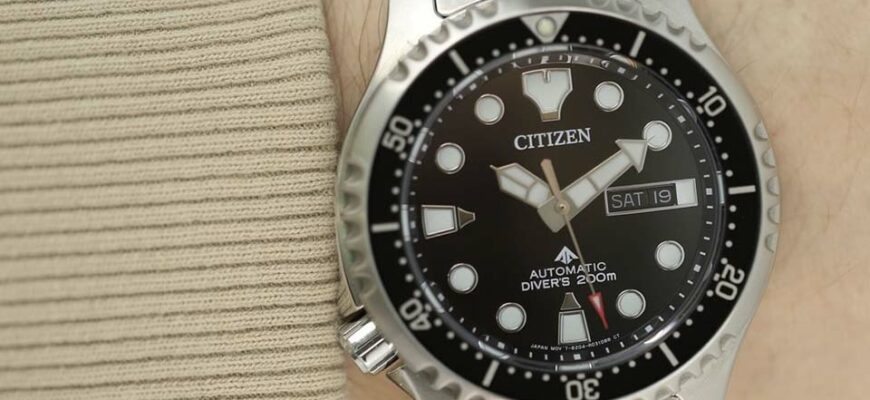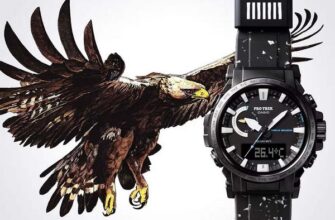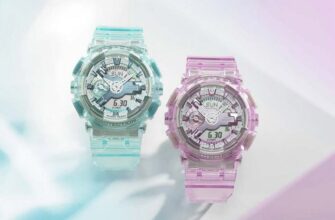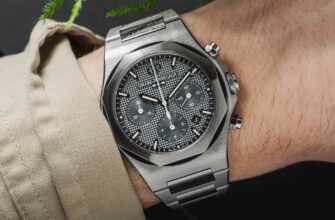First impression of the Citizen NY0140-80E: what a rarity, a watch with an “8 o'clock” crown! Second: yes, this is a real tank in a tailcoat - a thoroughbred diver, but what an elegant one. Thirdly, it turns out that much of the rich history of Citizen has entered the DNA of this watch. An interesting model, whatever one may say.
Rare rarity: crown "at 8"
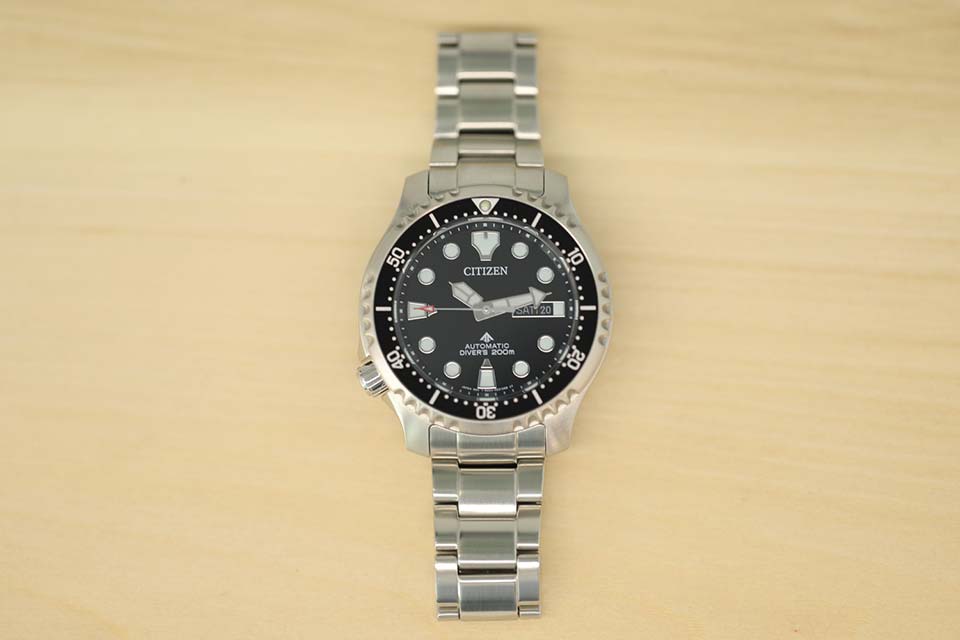
Massively wearing a watch on the wrist instead of a pocket began at the beginning of the 20th century. They had to be wound manually, since self-winding watches became widespread only towards the middle of the 20th century. About 90% of people in the world are right-handed, that is, most owners found it more convenient to turn the crown located on the right with their right hand. Not surprisingly, its traditional location is "at 3 o'clock".
Now most watches are also like this, but over the years, models with a displaced crown have appeared on sale - for every taste and for every hand.
Sometimes the crown is moved due to the technical features of a particular watch, more often for convenience. There are quite a few watches with a crown on the right “at 4 o’clock” so that it does not rest against the wrist when the left hand is bent. Such are many Seiko diving and sports watches - from Grand Seiko, Marinemaster and Tuna to budget Seiko 5. There are noticeably fewer watches with a "2 o'clock" crown - for example, our Chistopol watch factory ("Vostok") has such watches.
There are crowns “at 12 o'clock” – for example, chronographs in the bullhead form factor (“bull's head”). Such, for example, are presented in the assortment in the Bomberg model range. Now it is easy to find a watch with a left-handed crown - like the "divers" Orient M-Force series EL06. If you wear them on your left hand, the crown certainly will not touch your wrist.
And the rarest options are watches with a crown on the left, shifted up or down. Whichever hand you put the watch on, it will not hurt. For example, Sinn has models with a 10 o'clock crown, while Citizen has an 8 o'clock crown. Such as our NY0140-80E.
The NY0140 inherits the 8 o'clock crown position from the classic 1997 Citizen Promaster Marine. I don't dive myself, but I read that this is a very rational solution for modern diving watches. A diving computer is now usually put on the left hand when diving, the right hand is left to the watch as a spare time meter. The crown located on the left-bottom does not interfere with the right wrist when diving, and in everyday life it is convenient to wear the watch on the left hand.
Often you won't have to touch the crown: the NY0140-80E has an efficient auto-winding (they will go if you just shake them a little), and manual winding is not required. Setting the time and date with your left hand is really unusual, but not at all difficult. But it’s nice to understand that you have a rare and unusual watch on your hand.
Tank in tailcoat
Perhaps Citizen divers are not as famous as the Blancpain Fifty Fathoms or the Rolex Submariner. But the Japanese company has its own rich "waterproof" history.
In 1953, the Swiss released the first divers of the modern type - the same Fifty Fathoms. And in 1959, Citizen introduced its Parawater water protection technology. In 1963-1964, about 200 Parawater watches were dropped into the sea off the coast of Japan, hung from floating buoys with a note in the spirit of "If you find this watch, report it to Citizen." In the following months and years, the buoys were gradually fished out - for example, one of them, along with the currents, crossed the Pacific Ocean and was found off the coast of the United States after 3 years - and all the watches caught worked normally.
The Parawater wasn't a diving watch in the modern sense, but you can remember the origins of the Citizen's water-resistant watches by looking at your NY0140-80E. It says "Diver's 200m" which means that the watch is ISO 6425 certified. This implies a 25% "water resistance margin" (watches with the WR 200 actually have to withstand the pressure of still water at a depth of 250m). It also includes requirements for shock resistance, readability of arrows and marks under water, anti-magnetism and several other parameters. In general, a tank, not a watch.
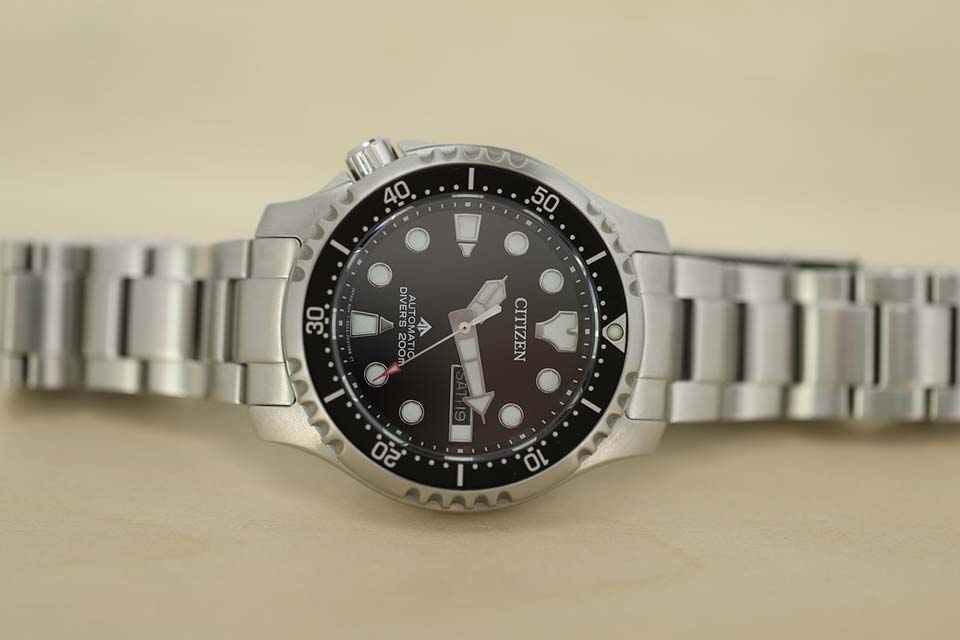
It is assumed that such a watch is a durable and reliable tool that is not spared and worn in difficult conditions. For such a tool, the Citizen NY0140-80E looks very elegant. The case and ends of the bracelet are polished “mirror-like”, the polished hands and dial markers shine under any light. True, there are doubts about the practicality of this decision ... But let's go in order.
Caliber: exceeding promises
Since this is a tool, let's start with functionality: timing. The watch is equipped with an automatic caliber Citizen 8204 with 21 jewels. It was designed in the 1970s, but for watch movements, this is a normal age. For example, Valjoux 7750, which is installed in many Swiss chronographs, is the same age as 8204.
In principle, 8204 has everything you need for comfortable use of the watch. Frequency - 21600 vibrations per hour. Theoretically, the higher the frequency, the more accurate the clock. 21600 is the average level.
For comparison, the Swiss Powermatic 80 has the same amount, while the Valjoux 7750 has 28800. The declared accuracy of 8204 is no worse than ± 20 seconds per day. As is often the case with Japanese watches, in fact, the watch turned out to be more accurate than the tolerances: they ran away by 20 seconds in three days of wearing in the “office” mode (from 7:00 to 19:00 - on the arm, the rest of the time - lying on the table with the dial up).
Claimed power reserve is 42 hours. The actual one is also a little better - it took about 45 hours from taking it off the hand to stopping, and after at least 40 hours the watch retained its accuracy. There is also a manual winding, although it is unlikely to be needed.
The 8204 is equipped with Parashock's proprietary shock protection to absorb shocks (such as when a watch is dropped) and protect the fragile balance axle from damage. In 1956 Citizen presented this technology in a very impressive way. Actions were held in 11 Japanese cities, during which they dropped Parashock watches from a helicopter hovering at a height of 30 meters, and then showed the public that they were still running.
The clock shows the time, date and day of the week in two languages: English and, suddenly, German. The crown has two positions. The first is a quick setting of the date (counterclockwise) and day of the week (clockwise). Date switching is not instantaneous, but rather fast; the instruction forbids manually translating the date around midnight. Switching the days of the week is tactilely very pleasant: quiet, clear clicks are felt and heard in the case when the disk falls into place. You feel something like confidence that the mechanism is of high quality, and when switching it, nothing will break or catch on it. In the second position, the crown translates the time, and there is a hack - stopping the second hand to set the time to the nearest second.
Eternal Sunshine Dark Dial
The overall impression of the dial is made by the hour markers - applied, polished, of complex shape, generously filled with luminescent paint - and massive polished hands. They shine, it is worth catching a ray of light. Even the lettering, including the Citizen logo, has a slight sheen. And it looks festive - like a Christmas tree.
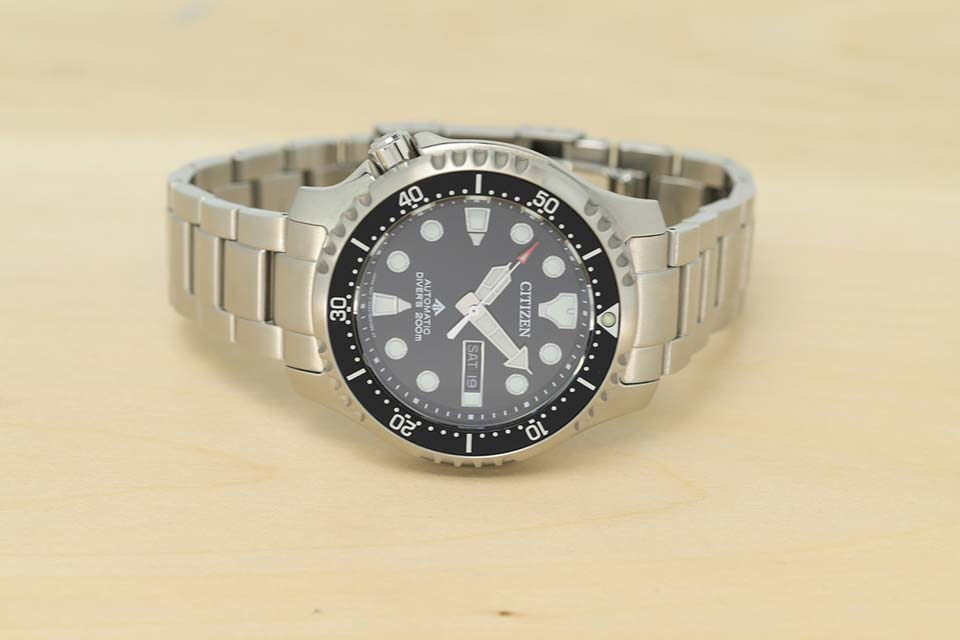
Readability is beyond praise. The dial is black, glossy and perfectly contrasts with the polished metal of the hands, markers and milky white luminescent paint on them. The glass is sapphire with an anti-reflective coating, and although there is still glare at some angles, the time readings are always read. There are no problems in the dark either: after exposure, the lume glows brightly and saturated, after a night it is paler, but quite distinguishable.
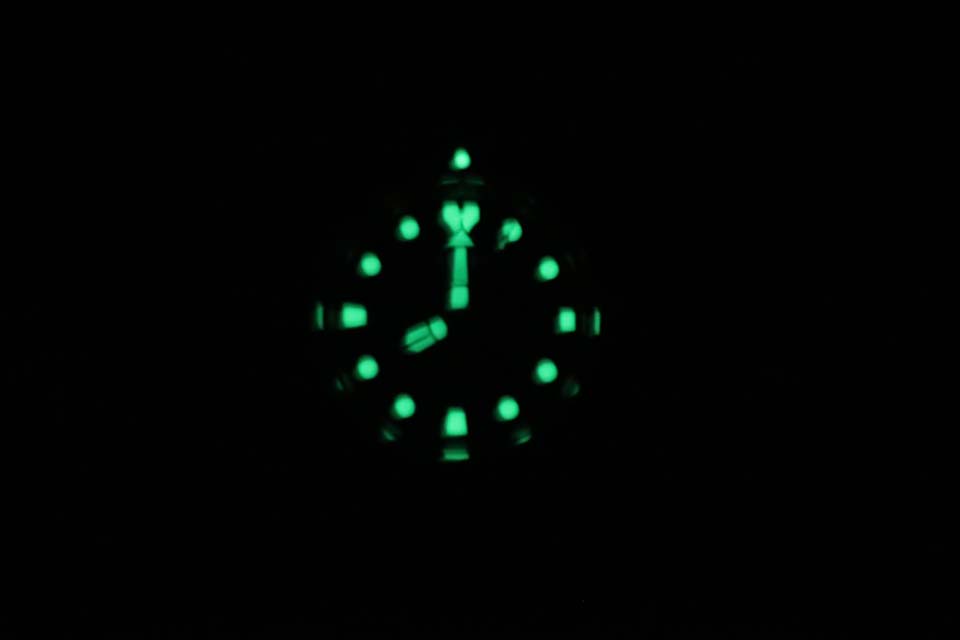
Massive, specific-shaped arrows are the same as those on the legendary Citizen Aqualand of 1985. The Aqualand, with its digital depth gauge and dive timer, was one of the last watches used by divers as their main working tool: from the mid-1980s, dive computers began to replace watches as ancillary equipment. If you have not dealt with Japanese diving watches before, then at first such hands look unusual. But after half an hour on the hand, their size and thickness are already taken for granted, especially since it is easy to distinguish time with an accuracy of up to a minute. The second hand with a red arrow on the tip looks good, but it would be even better if it reached the markings. However, this does not interfere with the use of the clock.
The aperture of the date and day of the week is excellent. The frame is laid on, neat, polished in a mirror. The date and day discs themselves are painted in the color of the dial and do not stand out with an alien white spot, as is sometimes the case on other watches. The number and day of the week are located exactly in the center of the aperture and are printed without visible flaws. But there is also a fly in the ointment: the discs are not tightly fitted to each other, and if you look closely, you can see a gap between them.
It is also better not to scrutinize the rest of the elements of the dial. Yes, the labels are overhead, even, without luma blunders - but absolutely flat. Arrows are stamped, without volume and edges. Logo - I would like not drawn, but invoiced. Understand correctly: in fact, these are not shortcomings, but nit-picking. But the first impression of the NY0140-80E is so good that you want perfection even in small things. In fairness: if you do not look at the watch at close range, you again enjoy their accuracy and festivity.
Case and bracelet: not bad, but impractical
The watch case and bracelet are well made, although there are some nuances.
The bezel is good. Of course, it is diving - unidirectional (as a safety measure when diving, it rotates only counterclockwise), for 120 clear, confident clicks. The zero mark becomes exactly opposite the 12-hour mark on the clock. Gritty, with a large notch - I don’t know how it is in diving gloves, but in woolen gloves it’s quite convenient to rotate on the street (by the way, the alternation of deep corrugation with smooth sections still quotes the same ancestor - the Promaster Marine model).
The “pearl” on the zero mark is generously and neatly filled with luminescent paint, and the black and white markings are well read. However, the black ring is an easily scratched IP coating, and it is better to be careful with it. True, the IP-coated insert is recessed by a fraction of a millimeter relative to the steel edge of the bezel - perhaps this will provide some protection ... However, the outer part of the bezel itself will perfectly collect scratches.
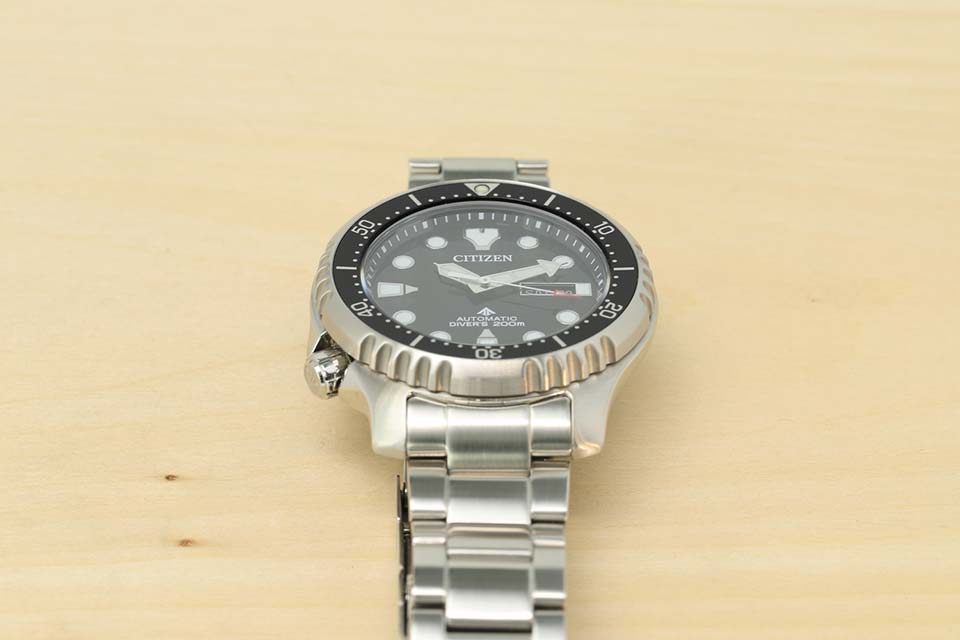
The bracelet is cast, with cast end links and small gaps at the junction with the case. There are no backlashes, the processing between links is no worse in quality than on visible surfaces. The gaps between the links are uniform, but quite noticeable. The ends of the links are polished in a mirror - any scratch will be visible.
The central part of the links and the clasp are finely brushed - probably, thin scratches will not be noticeable, but large ones will definitely be visible. Clasp - comfortable, triple addition with pushers-clamps.
The inner part is stamped and again polished in a mirror, but I would like, of course, milled. The bracelet itself feels a bit thin for a massive watch, but this is a double-edged sword. A watch on a full bracelet already weighs a solid 170 grams, and a thicker clasp and bracelet would have added to this weight.
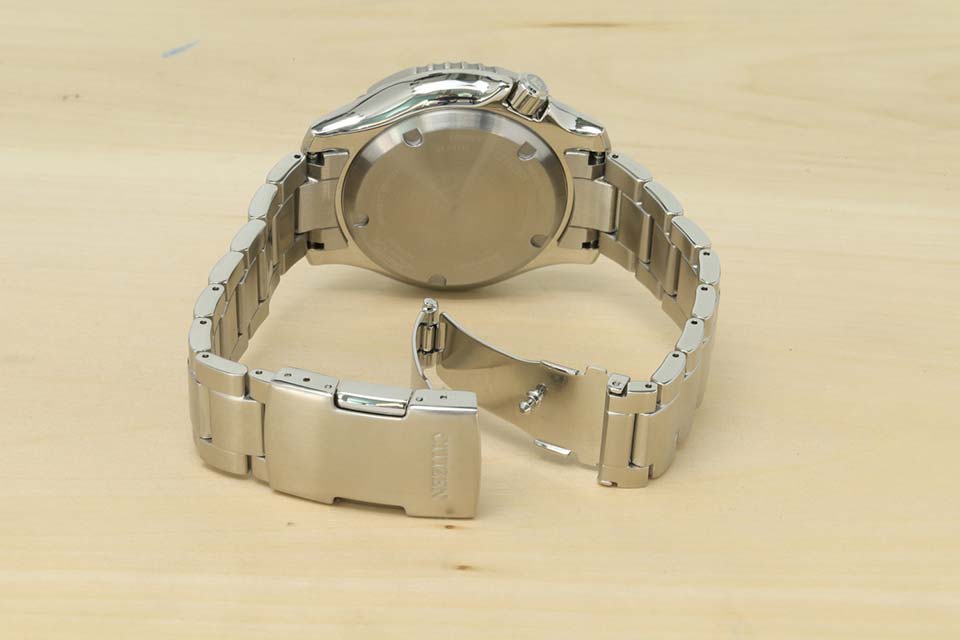
The case has very soft, smooth edges. At the bottom, at the lid of the watch, it is noticeably narrower than at the bezel, so in profile it looks like a flying saucer. The case is also polished, and if something scratching gets to the sidewalls, the marks will definitely remain. The screw-down case back is made a la Rolex: there is nothing on it except service information, even the company logo.
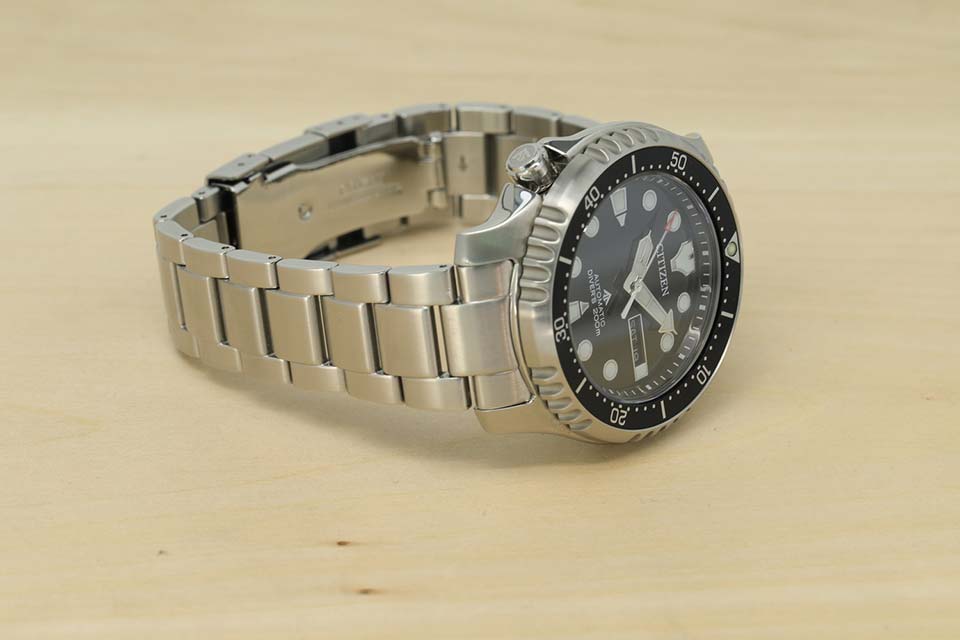
The crown is very pleasant - large, grippy, with a deep notch. She, of course, is also screwed and noticeably spring-loaded. On it, as well as on the dial, there is a logo in the form of folded arrows - the emblem of the Promaster line, to which the NY0140 belongs. Citizen launched this line in 1989, positioning it as a watch for professional use in water, air and on land - in a word, gathered all watches for an active lifestyle under one name.
Previous sports lines "merged" into Promaster, at the same time giving him their former slogans Go higher (Higher!) And Go deeper (Deeper!). Therefore, the Promaster logo is a stylized image of arrows pointing up and down. By the way, the central part of the crown is matte and slightly recessed, and a polished logo protrudes above it by a fraction of a millimeter. It looks much more interesting than a simple engraving.
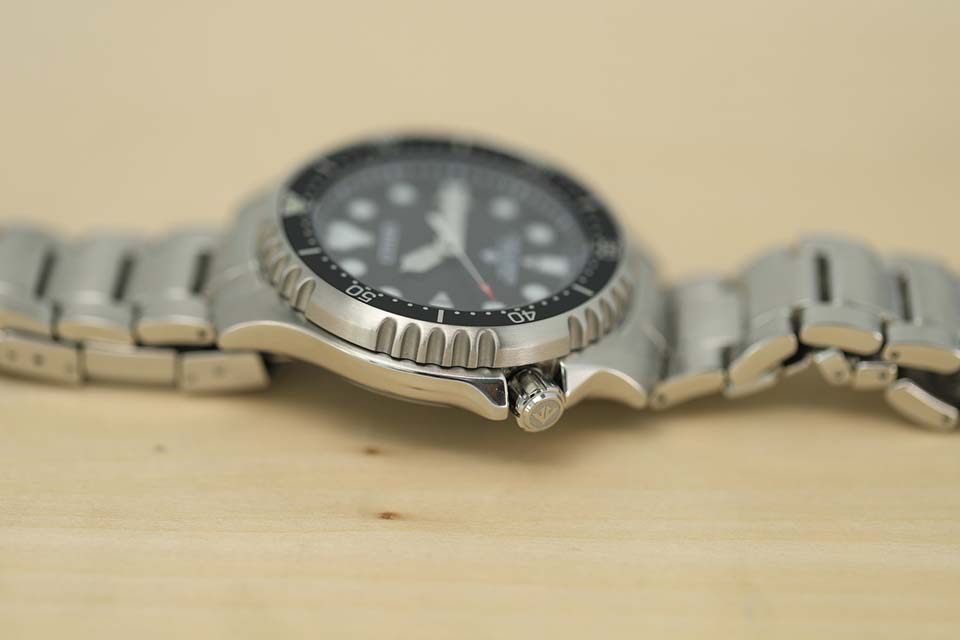
The size of the watch is quite comfortable – about 50 mm from ear to ear, the diameter including the crown is 44 mm. On a thin wrist of 16,5 cm they sit quite comfortably, albeit at the limit. However, they are quite plump (13 mm), and pulling them out from under the sleeve of a winter jacket is a real adventure.
Summary
The Citizen NY0140-80E is a reliable diving watch. You can take them with you for diving and hiking - they should be a tenacious and durable companion. But is it necessary? “Whatever doesn’t kill me ruins my polish and scratches the bezel” is how NY0140 could paraphrase Friedrich Nietzsche.

On the other hand, this is a powerful, reliable men's watch - diving certification confirms this. They are reminiscent of memorable events and models from the history of Citizen (Parawater, Aqualand, Promaster Marine) - wearing such a watch with a background is even more pleasant. They look interesting - festive due to the game of polishing on the marks and hands, but not flashy due to the black dial. Thanks to their versatile design, they can be combined with clothes of different styles up to smart casual.
So, rather, this is a desk diver - a “desk diver”, “a tank in a tailcoat”, a true diving watch that will feel best in urban use.
